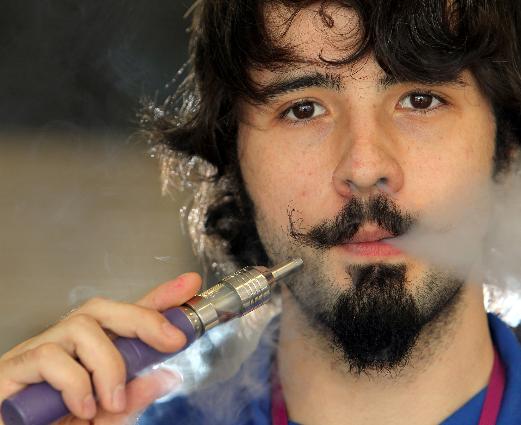World Health Organization: Public Health Rules Needed to Curb E-Cigarette Risks
by Katie Weatherford, Center for Effective Government
Contrary to industry advertising, a new report by the World Health Organization (WHO) finds that electronic cigarettes (e-cigarettes) and other electronic nicotine delivery systems pose significant public health hazards because of toxins emitted from the devices. The agency recommends that countries adopt e-cigarette rules to prevent misleading marketing of the products and to educate the public about the potential health risks involved.
E-Cigarettes Emit Dangerous Toxins
E-cigarettes contain a battery that heats a nicotine fluid inside the device until it produces a mist-like aerosol that the user can inhale. According to the WHO report, the aerosol contains “nicotine and a number of toxicants” that pose health hazards to users and non-users, especially pregnant women and children, contrary to claims that these devices release nothing more than water vapor. Nicotine use is linked to long-term adverse effects on brain development. Moreover, the aerosol typically contains “some carcinogenic compounds,” including formaldehyde.
Although the report finds that adult smokers who completely switch from regular cigarettes to e-cigarettes will be exposed to lower levels of toxins, WHO warns that the “amount of risk reduction . . . is presently unknown.” The report also notes uncertainty about whether second-hand exposure risks from e-cigarettes are lower than regular cigarettes.
Marketing Contains Unsubstantiated Claims, Targets Children
The WHO report also takes misleading marketing to task, noting the frequent use of unsubstantiated claims about e-cigarettes in product ads. According to the report, there is insufficient evidence that using e-cigarettes will help people quit smoking, yet ads commonly market e-cigarettes as a smoking-cessation device. Other marketing tactics may even encourage more frequent smoking.
For example, many ads promote using e-cigarettes in places where regular smoking is banned. WHO cautions that this could interfere with the intent of smoke-free policies, which “are designed not only to protect non-smokers from second-hand smoke, but also to provide incentives to quit smoking and to denormalize smoking . . . .”
Moreover, e-cigarette marketing has “the potential to glamorize smoking,” which may encourage nonsmokers and children to start using e-cigarettes. The endless variety of designs and flavor options can also appeal to adolescents.
WHO Recommends Developing Public Safeguards
The WHO report says, “Regulation of [e-cigarettes] is a necessary precondition for establishing a scientific basis on which to judge the effects of their use, and for ensuring that adequate research is conducted, that the public has current, reliable information as to the potential risks and benefits of [e-cigarettes], and that the health of the public is protected.”
The report will be a topic of discussion this October at the Sixth Conference of the Parties to the WHO Framework Convention on Tobacco Control. The Convention is an international effort to address global tobacco use. The report calls on the 179 countries that are parties to the Convention to adopt new standards to protect the public from the hazards associated with e-cigarettes. Such safeguards would:
-
Prohibit claims that these products can help people quit smoking until manufacturers provide sufficient scientific evidence to support the claim and gain regulatory approval
-
Ban indoor use of e-cigarettes unless it is proven there are no health effects from second-hand exposure
-
Restrict marketing by requiring that all ads, promotions, or sponsorships provide warnings, encourage people to quit smoking, in no way promote use by nonsmokers or adolescents, contain no images, words, etc. associated with a tobacco product, and more
-
Require that manufacturers design products to reduce exposure to toxins, make information about contents and exposure levels available to users, register products with a governmental body, and report design and emissions information to a governmental body
-
Prohibit sales to people under the age of 18 and ban fruit, candy-like, and alcohol-drink flavors unless and until it is proven that these flavors do not appeal to minors
To ensure strong public health protections, the global community must adopt WHO’s recommendations so that people understand the risks associated with e-cigarettes and adults can make informed choices about whether or not to use them.
Protecting Public Health in the U.S.
Although the U.S. is a signatory to the Convention, it has not yet ratified the tobacco control treaty. However, the U.S. Food and Drug Administration (FDA) is taking some steps similar to WHO’s recommendations.
FDA proposed a rule in April that would ban the sale of e-cigarettes to anyone under the age of 18. The rule would also require e-cigarette manufacturers to register with the agency and report the manufacturing process and ingredients used in their products. Moreover, companies would be required to place health-warning labels on e-cigarettes.
However, some tobacco control advocates believe the proposal does not go far enough and are urging FDA to prohibit manufacturers from marketing candy-flavored options that attract children. The Center for Effective Government and other health and safety groups also heavily criticized the FDA’s decision to discount the benefits of the proposed rule by 70 percent, which the agency claims is necessary to account for the “lost pleasure” from reducing tobacco use.
FDA is currently reviewing public comments and considering any changes to its draft rule. We hope the agency will correct its flawed benefit calculation and move forward with strong safeguards without delay. The U.S. should also ratify the treaty and communicate its support for global efforts to combat the tobacco use epidemic.



